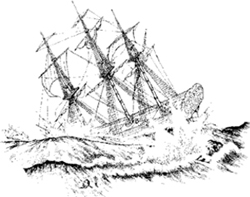Authors: Dan Lewis
Now I Know More (15 page)
POLAND'S UNLIKELY WORLD WAR II HERO
In January of 1944, Europe was in the throes of war, and seemingly nothing (save perhaps for Switzerland) was beyond its theater. About eighty miles outside of Rome was the abbey of Monte Cassino, a monastery dating back to 529. The Germans decided to not occupy the abbey in spite of its tactical valueâit was placed on top of a hill and made an excellent location for lookoutsâlikely in deference to its history. However, American intelligence erroneously determined otherwise and the air force bombed the abbey, reducing it to ruins. German soldiers then paratrooped in, and for the four months that followed, Allied and Axis battled over the region. All together, the two sides suffered casualties numbering as high as 75,000; the Allies ultimately prevailed.
But the Battle of Monte Cassino is not only known for its relatively high casualty count or the American intelligence failure. Another hallmark of the battle was the diversity of Allied troops who fought there. There were soldiers from the United States, Great Britain, the French Underground, New Zealand, Canada, British India, Poland, some anti-Mussolini Italians, and even an Iranian. The Iranian's name was Wojtek.
Wojtek was a bear.
(Yes, an actual bear.)
Wojtek was discovered by a local Iranian boy in 1942 when he was just a cub. The boy sold him to a group of men in the Polish Army who were engaged in battle in the regionâapparently, the soldiers wanted a pet/mascot, and the boy wanted some of their rations. Wojtek quickly became one of the boys, even taking up cigarettes, according to the
Scotsman
. (Wojtek did not just smoke themâhe also ate them.) As his company moved throughout the Middle East, Wojtek became increasingly popular with the troops, but when British ships came to move the Polish Army into Italy, only enlisted men and officers were allowed on board. So the Polish Army did what seemed at the time to make sense to someone: They drafted Wojtek into service. He joined as a private in the 22nd Artillery Supply Company of the Polish II Corps.
As a private, Wojtek was no longer just a marmalade-loving curiosityâhe had to live in the tents with his fellow enlisted men and, when duty called, press into battle. Being a bear, there were few jobs he could do. (Even if he were a super-intelligent bearâand there was no evidence that he wasâhe could not, for example, shoot a rifle, as bears lack opposable thumbs.) However, as legend has it, he actually did something useful during the Battle of Monte Cassino. Private Wojtek acted as a transportâmoving heavy crates of artillery from the supply lines to the weapons. According to the witnesses who swear that it happened, Wojtek did so perfectly, never dropping a single crate.
After the war, Wojtek found a permanent home in the Edinburgh Zoo. It became customary for Polish soldiers to visit him and, when they did, to toss him a cigaretteâwhich Wojtek would then smoke. He lived to be twenty-two years old, finally passing on in 1963. To date, he's the world's only known war hero who happens to be a bear.
American icon Smokey Bear was created in 1944 by the U.S. Forestry Service to educate the public about the dangers of forest fires (and how to prevent them from occurring). By 1964, Smokey was receiving so much fan mail that the U.S. Postal Service issued him his own ZIP code. It's 20252.

WHAT GOES DOWN MUST COME UP
Reflecting back on World War II, British Prime Minister Winston Churchill once wrote that “the only thing that really frightened me during the war was the U-boat peril.” U-boatsâthe German submarine fleetâpatrolled the Atlantic throughout the war, wreaking havoc on Allied convoys carrying troops, supplies, and everything else flowing between the United States and Western Europe. Over the course of the war, German forces sank nearly 4,000 ships and took the lives of roughly 75,000 sailors and merchant marines, in no small part due to the advantages gained by this submarine fleet.
Over time, Allied forces developed different ways to detect and, ultimately, destroy these subs. On April 14, 1945, the British managed to sink one of the U-boats without any technological advantagesâat least not on the Allies' partâshortly after it surfaced just off the shores of Scotland.
Why would the U-boat surface there? The crew didn't have a choice.
Someone flushed the toilet when he shouldn't have.
That's not a euphemism for a screwup, eitherâthat's quite literally what happened. This U-boat was a very new oneâit was on its first (and last) patrolâand it had some new features. For example,
U-1206
was outfitted with a special type of toilet that allowed the men on board to hit the head while the submarine was well below the ocean's surface. This wasn't a simple “do your business and pull the chain” toilet. Operating itâthat is, flushing itârequired training, and not everyone on the U-boat had been so educated. Those who availed themselves of these toilets during deep-sea dives needed to call in one of these specifically trained toilet flushers to finish the job. Apparently, someone forgot that step.
The errant flush caused a leak and water entered the U-boat's batteries, which, according to
Wired
, were located beneath the toilet. The waterlogged batteries began to emit chlorine gas, which is toxic. So the U-boat's crew, facing near-certain death if they stayed at dive depth, surfaced to air everything out.
Before the crew could fix the problem and clear out the toxic fumes, the ship was detected by the British and, shortly thereafter, sunk by the Royal Air Force. Four men aboard were killed, the other forty-six captured by the British, and
U-1206
was destined for an eternity at the bottom of the North Sea, its super-toilets submerged under 200 meters of water.
More than three dozen nations (through 2013) now have submarine fleets. If one were to rank the fleets by the number of subs, Russia, China, and the United States would be in the top four, which makes sense given the respective size of their nations, economies, and militaries. But none of them are atop the list. Number one? Perhaps surprisingly, it is North Korea.

WHY WOMEN AND CHILDREN GO FIRST
The apex of chivalryâat least, in the romanticized sense of the wordâoccurs on a boat destined for the bottom of the ocean. “Women and children first” is the rallying cryâthe idea being that lifeboats should go to them first, and that men, like the captain, should go down with the ship if need be. The ritual is so ingrained in our culture that we almost expect it as a plot element in any story, fiction or nonfiction, involving such a disaster. But where did it come from?
In 1852, a British frigate, HMS
Birkenhead
, was charged with transporting troops from England and Ireland to South Africa as part of a decades-long military campaign against the native peoples, called the Xhosa Wars. Also on board were the wives and families of many of the officers; they were allowed to stay with their husbands while the men were stationed overseas. But the
Birkenhead
would never arrive at her intended destination. While making her way around Western Cape, the South African province that calls Cape Town its capital, the
Birkenhead
hit a submerged, uncharted rock and began to take on water. The captain ordered the soldiers on board to help pump the ship dry, but it soon became clear that the
Birkenhead
was doomed to plummet to the ocean's bottom. The captain changed his order. Everyone who was able to swim was to jump overboard and make it to lifeboats now in the water. Everyoneâman, woman, and child alike. Even the nine cavalry horses being transported were blindfolded and cajoled overboard, in hopes that they could make the two-mile swim to shore.
But for the soldiers, the captain's order was subordinate to that of their commanding officer, Lieutenant-Colonel Alexander Seton. Seton, likely fearing that a mad rush to safety would cause further harm (and put lifeboats at risk), ordered his men to stand pat, allowing the women and children to take to the boats. Almost all the soldiers followed the order and stood on the ship, likely dooming themselves to death, as the
Birkenhead
broke up into the cold ocean water surrounding its shattering hull. Of the 640 or so people aboard the
Birkenhead
(we don't have an exact number because the records sank with the ship), just under 200 survived, most of them women and children. (Oh, and eight of the nine horses managed to survive, too, in case you were wondering.)
The idea that women and children should be allowed to evacuate first became a maritime practice soon after, but the phrase “women and children first!” did not enter naval parlance for almost a decade. By the time the HMS
Titanic
sank in 1912, the custom was well established. Nearly 75 percent of the women and more than 50 percent of the children aboard the doomed ship survived, compared to only 20 percent of the men.
The Xhosa Wars are named after the Xhosa, indigenous people in South Africa who resisted British imperialism. In 1856, a teenage Xhosa girl named Nongqawuse went to the cattle fields to scare away birds. While there, she'd later say, she was visited by three spirits. They told her that to triumph over the British settlers, the Xhosa needed to kill all their cattle and raze all their crops. The prophecy made its way to the chief of Nongqawuse's clan, who believed that the visions were real and ordered the slaying of an estimated 300,000 cattle. This resulted in a massive famine among the Xhosa, resulting in the death of roughly 40,000 of their people.

HOW WOOD PLUS GRAPHITE EQUALED RACISM
From the 1940s until 1994, South Africa was an apartheid stateâpeople were classified based on their race, with whites having rights that were denied to blacks. But “white” and “black” wasn't the end of the classification system. Mixed-race peopleâcalled “coloureds”âwere considered a class unto themselves. While black people were discriminated against in almost all aspects of life, mixed-raced people were generally afforded more rights than blacksâyet were hardly considered equal to whites.
“Mixed-race” isn't an easily defined class. How many white grandparents or great-grandparents does one need to be considered “white”? Or “mixed-race”? Apart from the fact that we shouldn't be classifying people in such a manner anyway, trying to answer that question is an impossible task that can only lead to absurd results. So it should surprise no one that South Africa's system involved something both outlandish and offensive, called the pencil test.
The pencil test, as Wikipedia explains, was a “method of assessing whether a person has Afro-textured hair.” A pencil was inserted into the person's hair and that person's racial category was determined by how easily it came out. If the pencil fell out, the testee was considered white. If the pencil stuck, then the person was ruled non-white. Black people could subject themselves to the test in hopes of being reclassified as coloured. In such a case, after the pencil was inserted into the person's hair, he or she was told to shake his or her head. If the pencil fell out, the person was from that point on considered coloured; otherwise, he or she remained black.
